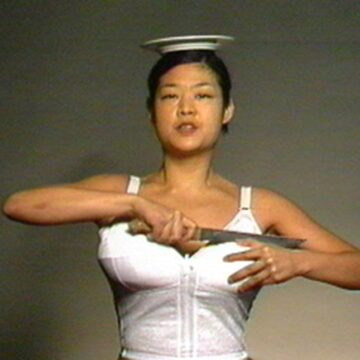Patty Chang (she/her)
Born San Francisco, CA 1972
Melons (At a Loss), 1998
VHS (color, sound)
3 minutes, 34 seconds
Rubell Museum, acquired in 1999
TRANSCRIPT
[00:00:00] When my aunt died, I got a plate. It was the kind of plate with a color photo printed on it in a poisonous ink that you couldn’t eat or else you’d die too. The original, which was made in a fine porcelain, was made back when my aunt and uncle got married.
Back in the days when black and white meant photos and color meant paint.
When she died, extras were ordered from Thrifty’s photo department. $10.99 for a saucer. [00:01:00] $29.99 for dinner. I was given a saucer and I was told it was because I was smaller and more petite than everyone else, not because it was cheaper. It came in a small box, wrapped in a dark olive paper. No silver curly cues.
No bows and plastic flowers, just plain with a piece of tape on either end.
And inside that box was a single saucer minus the cup and a redwood display stand.
And on that saucer was an image of my aunt two years before she died with a smile so wide her eyes disappeared [00:02:00] into hairline slits, almost erased into her skin. And she was just like St. Lucy, St. Lucy of Syracuse—eyeless, sightless, and carrying her baby blues on a platter, two ripe, round grapes like I’d put on dish on Halloween when I was nine and I’d make my 10 year old boyfriend put his fingers in into it and I tell him, “They’re my dogs’, can’t you tell? I pulled ‘em out today just for you.” And right there on the spot he’d confess his undying love to me.
But she was power incarnate, and I imagine that she could see into whatever room that she left her eyes, [00:03:00]
and I looked up to my plate just as Lucy did hers. I thought I understood all the powers that it held.
And whenever I was punished for not doing something I was told to, I would gently take that plate off of its redwood display stand (sound of plate shattering) and lick that puppy till her smile was erased.
DESCRIPTION
Patty Chang uses her body as a medium for probing at questions and pushing boundaries around the
female body, and particularly through the lens of her experiences as a queer Asian American woman.
Melons (At a Loss) was a response to the emotional void created by the death of the artist’s aunt from
cancer. The apparent violence of cutting can also be seen as an act of removing malignant elements or
rebelling against societal expectations for feminine bodies. Eve Oishi, associate professor of cultural
studies at Claremont Graduate University, describes Chang’s process in a 1999 article: “Chang’s body of
work is drawn together by the bold, outrageous, and yet subtle use of her own body to test the borders
of flesh and the body and to explore the physical and ideological ways in which women’s bodies are
stitched, clamped, hooked, squeezed, and dismantled into femininity.”
Rebel/Re-Belle is organized by the Asheville Art Museum. Generous support for this project is provided by the National Endowment for the Arts. Essential support provided by April Liou and Kevin Click.


